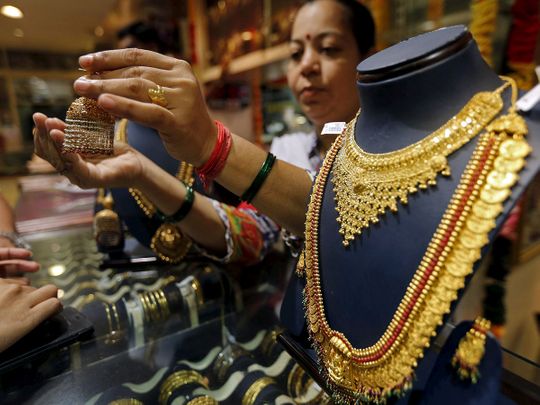
Dubai: The legions of Indian consumers holding gold will have nothing to worry about the new government regulations on 6-digit hallmarking that comes into full effect from April 1. The new requirements will also not have any bearing on gold brought into the country by expats or residents returning to India.
The hallmarking change also will not "impact in any way Indian expats wanting to sell their gold holdings at any point in India," said Abdul Salam K.P., Vice-Chairman of Malabar Gold & Diamonds. "Gold retailers in India will still buy that gold based on the metal's price, melt it and apply for the new hallmarking. The hallmarked gold will be sold thereafter in the stores.

But there is no threat to individuals bringing gold into India and wanting to sell to take advantage of the lower retail price if bought in the UAE or Gulf.
Similarly, Indians holding gold - whether inherited or bought through the years themselves - need have no concerns about the rule.
READ MORE
- Why ‘916’ has such a bearing on Indian consumers’ psyche when talking purity
- Why it is easier to sell gold jewellery at a profit compared to bars, biscuits, or coins
- Joyalukkas Jewellery confirms 30 new stores in 2023, including Saudi Arabia, India
- ‘DigiGold’: Is buying virtual gold as good as spending on the physical form of the metal?
India is the world’s second largest consumer of gold after China, and despite stiff import duty on bullion, the Indian’s appetite for the metal has run consistently through the years, except for in 2020 and first-half of 2021, when Covid-linked lockdowns brought demand to a near halt. Even then, gold buying was one of the first consumer categories to arise out of the Covid disruptions. And Indians were seemingly making up for lost time by snapping up gold during 2022. Even when import duty was hiked to 15 per cent and what that meant for retail prices. (Apart from the buying and selling, gold fuels Indians’ financing needs too, with both individuals and SME owners using it as collateral to tap ‘gold loans’ through specialised financing companies. In India, gold matters.

The new hallmarking of gold in India is arbitrarily implemented. It is almost impossible for all retailers in the country to implement and this will certainly affect retail sales in India. While customers can be assured about the purity of gold, on account of this, I feel it will affect the people involved in the trade. The number of hallmark centres across India are limited and I am skeptical if they will be able to assess the purity within a short time. It may take some time for a smoother process since demand outweighs supply.
This is also why the government wants to create extra layers of transparency between the gold that gets turned into jewellery and is then sold to the consumer. What hallmarking does is make sure retailers adhere to certain standards – or in this case, ‘purity’.
Tough deadline for gold retailers
But retailers in India will have their work cut out – they have to ensure that every bit of gold sold at their stores from April 1 have the new hallmarking standard. That, according to multiple industry sources, is going to be one difficult task.
What's new with India's hallmarking rules:
- New Hallmarking Unique Identification Number (HUID) requires BIS logo, caratage, a 6-digit alphanumeric number.
- The old hallmarking rule required BIS logo, caratage, the hallmarking center's name, and jewellery shop's name.
From 4 to 6 hallmarking
With the mandatory 6-digit hallmarking, the Indian government wants to clamp down on gold entering the Indian retail market via smuggling or through other ‘parallel’ channels. It replaces the 4-emblem hallmarking that was prevalent earlier.
Retailers have been told to get all the gold they carry in their showrooms or order books feature the 6-digit hallmark by April 1, which coincides with the start of a new financial year in India. This is where the difficultly lies.

There are 500,000 licensed gold retailers in India – and many still have a mix of the old and new hallmarked gold in their stores. said
“There aren’t that many hallmarking centres to cover all the districts in India. Meeting the April 1 deadline on all gold carried in stores will be next to impossible. The gold retail industry could have done with more time being granted by the Indian government to be fully compliant."
Cut down smuggling
Where the 6-digit hallmarking would come in handy is to place serious pressure on gold bars entering India through grey channels. According to industry sources, these bars feed into a highly unorganised parallel market, where few questions are asked about the antecedents of what's bought and sold. With the digital hallmarking stamp compulsory for all retail channels, it's felt that these parallel markets would feel the pressure of having to show further proof of veracity.
"The parallel gold market fed by smuggled gold was seriously undermining the organised industry, especially the small and mid-sized retailers across the length and breadth of the country," said Nazar. "If the tightened digital hallmarking changes that, it would be a major breakthrough."
How hallmarking will work
Think of it as a certificate, where all the details attesting to the gold’s purity, caratage and other aspects are forever linked to a digitally secure six-digit figure. What the Indian authorities are trying to do is make sure only bullion brought in through regular and licensed channels make it to the stores. And thereafter sold on.
The tighter hallmarking and record-keeping will make it difficult for smuggled gold to get ‘mixed’ into the official channels and then recirculated into the economy. “India made hallmarking compulsory only in 2021 – from that to this 6-digit requirement is a major leap,” said Nazar. “The parallel importers will find it difficult to push their stock into the official channels.
“When that happens, these operators will be stuck with their goods that would find it difficult to get buyers.”
‘Cleansing’ the gold trade
For years now, Indian authorities had been trying to find some ways to rid the trade of unsavoury practices. The challenges still remain even with the tougher hallmarking entering all of India’s organised gold trade. But this time, if the enforcement is done effectively, the results could be there.
Whether it has succeeded or not will lie in whether there is a decisive drop in smuggled gold entering India through its airports. If that happens, the government will be the winner. It will not be the only one.
From April 1, the Indian gold consumer can look forward to greater reassurance at what he or she is buying is the real deal. That in itself is worth its weight – in gold.







